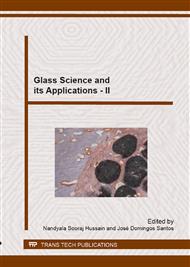[1]
Zitzmann NU, Berglundh T. Definition and prevalence of peri-implant diseases. J Clin Periodontol 2008;35:286-291.
DOI: 10.1111/j.1600-051x.2008.01274.x
Google Scholar
[2]
Mombelli A, Lang NP. The diagnosis and treatment of peri-implantitis. Periodontol 2000;1998:17:63-76.
DOI: 10.1111/j.1600-0757.1998.tb00124.x
Google Scholar
[3]
Pontoriero R, Tonetti MP, Carnevale G, Mombelli A, Nyman SR, Lang NP. Experimentally induced peri-implant mucositis. A clinical study in humans. Clin Oral Implants Res 1994;5:254-259.
DOI: 10.1034/j.1600-0501.1994.050409.x
Google Scholar
[4]
Albrektsson T, Isidor F. Consensus report of session IV. In Lang NP and Karring T (eds). Proceedings of the first European workshop on Periodontology, pp.365-369, London, UK: Quintessence.
Google Scholar
[5]
Misch CE, Strong JT, Bidez MW. Scientific rationale for dental implant design. In Misch CE, ed. Contemporary Implant Dentistry, 3rd ed, Mosby;2008:200-229.
DOI: 10.1016/b978-0-323-07845-0.00015-4
Google Scholar
[6]
Koldsland OC, Scheie AA, Aass AM. Prevalence of peri-implantitis related to severity of the disease with different degrees of bone loss. J Periodontol 2010;81:231-238.
DOI: 10.1902/jop.2009.090269
Google Scholar
[7]
Quirynen M, De Soete M, van Steenberghe D. Infectious risks for oral implants: A review of the literature. Clin Oral Implants Res 2002;13:1-19.
DOI: 10.1034/j.1600-0501.2002.130101.x
Google Scholar
[8]
Becker W, Becker BE, Newman MG, Nyman S. Clinical and microbiologic findings that may contribute to dental implant failure. Int J Oral Maxillofac Implants 1990;5:31-38.
Google Scholar
[9]
Alcoforado GA, Rams TE, Feik D, Slots J. Microbial aspects of failing osseointegrated dental implants in humans. J De Parodontolgie 1991; 10:11-18.
Google Scholar
[10]
Augthun M, Conrads G. Microbial findings of deep peri-implant bone defects. Int J Oral Maxillofac Implants 1997;12:106-112.
Google Scholar
[11]
Salvi GE, Aglietta M, Eick S, Sculean A, Lang NP, Ramseier CA. Reversibility of experimental peri-implant mucositis compared with experimental gingivitis in humans. Clin Oral Implants Res 2012;23:182-190.
DOI: 10.1111/j.1600-0501.2011.02220.x
Google Scholar
[12]
Schwarz F, Sahm N, Schwarz K, Becker J. Impact of defect configuration on the clinical outcome following surgical regenerative therapy of peri-implantitis. J Clin Periodontol 2010;37:449-455.
DOI: 10.1111/j.1600-051x.2010.01540.x
Google Scholar
[13]
Behneke A, Behneke N, d'Hoedt B. Treatment of peri-implant defects with autogenous bone grafts: six months to 3-year results of a prospective study in 17 patients. Int J Oral Maxillofac Implants 2000;15:125-138.
Google Scholar
[14]
Schwarz F, Beiling K, Latz T, Nuesry E, Becker J. Healing of intrabony peri-implantitis defects following application of a nanocrystalline hydroxyapatite (Ostim) or a bovine derived xenograft (Bio-Oss) in combination with a collagen menbrane (Bio-Gide). A case series. J Clin Periodontol 2006;33:491-499.
DOI: 10.1111/j.1600-051x.2006.00936.x
Google Scholar
[15]
Talreja PS, Gayathri GV, Mehta DS. Treatment of early failing implant by guided bone regeneration using resorbable collagen membrane and bioactive glass. J Indian Soc Periodontol 2013;17:131-136.
DOI: 10.4103/0972-124x.107490
Google Scholar
[16]
Lehmann B, Bragger U, Hammerle CH, Fourmousis I, Lang NP. Treatment of an early implant failure according to the principles of guided tissue regeneration (GTR). Clin Oral Implants Res 1992;3:42-48.
DOI: 10.1034/j.1600-0501.1992.030107.x
Google Scholar
[17]
Sooraj Hussain N, Botelho CM, Lopes MA, Santos M, Lobato JVPinto RM, Gutierres M and Santos JD, "Calcium phosphate – based materials for Bone Regenerative Medicine", for the book titled "Biomaterials for Bone Regenerative Medicine' Trans Tech Publishers (ttp), (2009), USA Chapter 6, pp.153-180.
Google Scholar
[18]
Sooraj Hussain N, Lopes MA, Mauricio AC and Santos JD. "Bonelike® graft for Bone regenerative applications. For the book entitled "Surface Engineered Surgical Tools and Medical Devices", Chapter 13, pp.477-512, 2007, Springer Publications, USA.
DOI: 10.1007/978-0-387-27028-9_13
Google Scholar
[19]
Lobato JV, Sooraj Hussain N, Sousa RC, Mauricio AC, Santos JD. Bone regeneration in maxillofacial surgery using novel Bonelike synthetic bone graft – radiological and histological analysis- J Biomater Appl 2008;22:373-385.
DOI: 10.1177/0885328207078260
Google Scholar
[20]
Lobato JV, Sooraj Hussain N, Lopes MA et al. Clinical application of titanium dental implants coated with glass reinforced hydroxyapatite Bonelike. Int J Nanomanufacturing 2008;2:135-148.
DOI: 10.1504/ijnm.2008.017845
Google Scholar
[21]
Kumar PG, Kumar JA, Anumala N, Reddy KP, Avula H, Sooraj Hussain N. Volumetric analysis of intrabony defects in aggressive periodontitis patients following use of a novel composite alloplast- A pilot study. Quintessence Int 2011;42:375-384.
Google Scholar
[22]
Koldsland OC, Scheie AA, Aass AM. Prevalence of implant loss and the influence of associated factors. J Periodontol 2009;80:1069-1075.
DOI: 10.1902/jop.2009.080594
Google Scholar
[23]
Zablotsky MH, Diedrich DL, Meffert RM. Detoxification of endotoxin-contaminated titanium and hydroxyapatite coated surfaces utilizing various chemotherapeutic and mechanical modalities. Implant Dent 1992;1:154-158.
DOI: 10.1097/00008505-199205000-00009
Google Scholar
[24]
Renvert S, Polyzois I, Maguire R. Re-osseointegration on previously contaminated surfaces: a systematic review. Clin Oral Implant Res 2009;20 (Suppl 4):216-227.
DOI: 10.1111/j.1600-0501.2009.01786.x
Google Scholar
[25]
Claffey N, Clarke E, Polyzois I, Renvert S. Surgical treatment of peri-implantitis. J Clin Periodontol 2008;35:316-332.
DOI: 10.1111/j.1600-051x.2008.01277.x
Google Scholar


